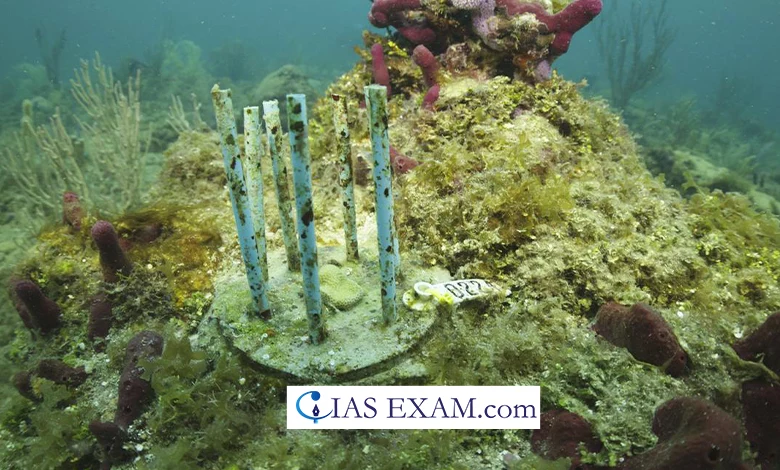Scientists Work to to Protect Young Corals from Fish
Syllabus: Environment and Conservation [GS Paper-3]

Context
Researchers in South Florida are utilising biodegradable straws to prevent lab-grown coral from being consumed by costly fish.
Key Points
- Scientists in South Florida are employing an innovative approach to protect laboratory-grown corals from being eaten by fish, particularly parrotfish, which are known to nibble on these young corals.
- They have developed a protective device called the “Coral Fort,” which is partly made from biodegradable drinking straws.
Details
- Coral reefs, often referred to as the rainforest of the sea, are vital to marine life, supporting approximately 25% of all marine species.
- However, these biodiversity hotspots face numerous threats, including predation by fish on newly transplanted corals.
- In South Florida, scientists are innovating to protect these vulnerable corals using an unlikely ally: biodegradable straws.
Predatory Problem
- The assurance of marine biologist Kyle Pisano and Kirk Dotson partner is that Pathogens and other predators, including parrotfish, pose a potential problem for the survival of genetically modified corals once moved to the ocean element.
- The coral larvae are forced to struggle with survival as the fish “treats it like popcorn” which causes an extinction rate of nearly 40%..
Straw Solution: Coral Fort
- In order to achieve this goal, Pisano and Dotson have designed the “Coral Fort,” a tiny biodegradable mould, a part of which is made of drinking straws.
- The introduction of this novel device to the industry has considerably enhanced the survival rates of transplanted coral to above 90%, which is a significant increment that might be pivotal in big-scale coral recovery projects.
Cost of Coral Loss
- The total coral reef loss per person can be $100, and the financial implications of coral predation are considerable.
- Plans involving the coral planting of thousands in the space of a year and tens of thousands over the next decade face the risk of being significantly reduced in scope unless the protection arrangement is highly effective.
Biodegradable Advantage
- The Coral Fort represents an eco-friendly responsive solution for the ongoing problem. Unlike the old coral restoration methods that involved stainless steel and PVC pipe barriers that needed to be maintained and removed, which ultimately posed a challenge for the humans, the Coral Fort being decomposed did away with your human involvement.
Science Behind Coral Forts
- The Coral Fort design reflects the agnostic attitudes of parrotfish lives and other predators’ behaviour. An example of this can be given for the parrotfish and other predators.
- Through the barrier the device gives fish a warning to stay away from the corals and still the water keeps circulating and light penetration unhampered everything necessary for corals to grow.
Environmental Impact
- The Coral Fort’s ambition is further enhanced by biodegradable materials just as it integrates into overall environmental sustainability.
- The Coral Fort is not only a solution to the problem of damaged reefs with a better accuracy than a conventional gardening method, but also it ensures the reduction of maintenance needs and marine debris pollution in coral reef restoration.
Global Context
- Coral reefs worldwide are under threat from various factors, including climate change, pollution, and overfishing.
- The decline of coral populations has prompted international efforts to save these ecosystems.
- The Coral Fort is a testament to the innovative approaches being developed to address global environmental challenges.
Conclusion
The development of the Coral Fort is a significant stride in the fight to save coral reefs. By grasping at straws, literally, scientists have found a way to protect infant corals from hungry fish, ensuring that these vital organisms can mature and contribute to the marine ecosystem. This approach exemplifies the creative and sustainable solutions necessary to address the pressing environmental issues facing our planet.
Source: The Hindu
UPSC Mains Practice Question
Q.Discuss the effectiveness of utilising biodegradable straws as a means to protect lab-grown coral from being consumed by fish. Evaluate the potential environmental and economic implications of this innovative approach in coral conservation efforts.





.png)



